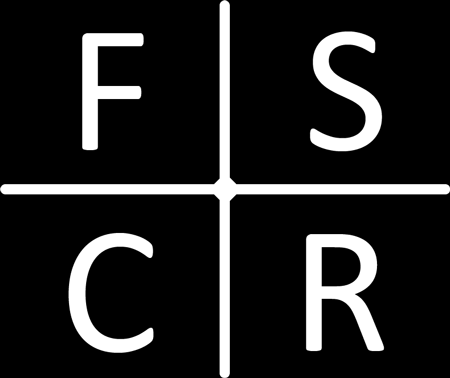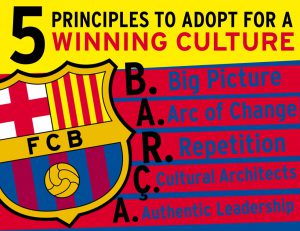Book Review – The Barcelona way: Unlocking the DNA of a winning culture (Damian Hughes)
The All Blacks, New England Patriots and Team Sky are all fantastic examples of consistent success in high performance sport. These institutions have created their own dynasty within their respective sports that have become the blueprint for other teams to aspire to. As a consequence of their prolonged success, there has been great interest in understanding exactly why and how they have achieved such an elevated status. There have been numerous documentaries on Bill Belichick and David Brailsford as well as some excellent books, in particular, James Kerr’s ‘Legacy’ on the All Blacks. Foregoing the individual training methods and sport specific differences, what is clear throughout each of these examples is that there is a clear mission and unified purpose amongst everyone involved that drives them to their successes. It is this ‘winning culture’ and shared mindset that is the hallmark of revered teams.
The closest footballing dynasty in recent years is arguably FC. Barcelona during the tenure of Guardiola from 2008-2012. In his latest book Damian Hughes delves deep into the DNA of the club to reveal the secrets to their success, which, he intricately stitches together with a clear strategy for any organisation to follow to ensure a winning culture is shaped. The following article will attempt to summarise the key messages covered in this book.
In order to establish a winning culture, it is essential that there is a universal commitment throughout the club. This buy-in is achieved through the application of five overarching principles that extend across the whole organisation. These principles are predominantly driven by the manager but also require substantial contribution from the players. The five principles spell out the acronym B.A.R.C.A and stand for the following:
- Big Picture
- Arc of Change
- Repetition
- Cultural Architects
- Authentic Leadership
Each of these principles will be looked at in isolation but it is the combination of all five that ultimately determines the success of the team.
The ‘Big Picture’ put simply is the ‘Why?’ you do what you do. It is in essence the higher purpose that can be used to connect people and provides a safety net to fall back upon whenever there is doubt or unrest within the organisation. Adopting something that is relatable and instils a sense of belonging is vital as it ensures a sense of unity which in turn will manifest as commitment to the culture. One phrase that sums this up for FC Barcelona is ‘Mes que un club’ which translates to ‘More than a club.’ This phrase embodies the political struggle that Catalonia has faced with respect to its independence against the Royalist Spanish territories over many years. Previous manager, Sir Bobby Robson famously said that ‘Catalonia is a country and Barcelona it’s army.’ Having such a vivid and emotional connection between the club and people of the region is something that will withstand the test of time and is an almost perfect ‘big picture’ to build your culture around.
Similarly, the big picture for FC Barcelona is supplemented by the vision and values of Johan Cruyff. The ‘total football’ approach which started when Cruyff was a player and extended into his managerial career with the side has been a hallmark of the club. Similarly, his insistence of training all youth teams on the same concepts and formations and challenging the best youth prospects by fast tracking them to the first team has become ingrained into the club’s philosophy.
Having the emotive motto ‘Mes que un club’ as well as the Cruyff footballing philosophy gives FC Barcelona’s ‘Big Picture’ both credibility and clarity, which, are essential for a winning culture. Interestingly, these two areas are also inherently linked whereby the future of the first team is being entrusted in the young footballers that are developed within the region. This can only strengthen the message and values that the club intends to project.
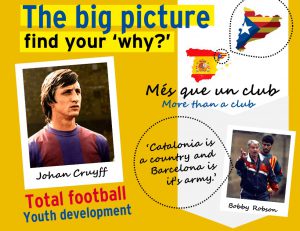 The ‘Arc of change’ relates to how to lead people through a successful cultural change. The journey starts with a dream or vision which is eventually realised as success arrives to the club in the form of a championship or trophy. The middle part of the journey is the most turbulent and in the words of Damian Hughes requires the manager and players to ‘leap,’ ‘fight’ and ‘climb’ to realise their potential. During these phases the manager can rely on speeches, stories, ceremonies and symbols to assist the players on their journey. Each of the aforementioned strategies ensure that the vision is tangible and represent checkpoints to remind the players of the cultural values that the club stands for.
The ‘Arc of change’ relates to how to lead people through a successful cultural change. The journey starts with a dream or vision which is eventually realised as success arrives to the club in the form of a championship or trophy. The middle part of the journey is the most turbulent and in the words of Damian Hughes requires the manager and players to ‘leap,’ ‘fight’ and ‘climb’ to realise their potential. During these phases the manager can rely on speeches, stories, ceremonies and symbols to assist the players on their journey. Each of the aforementioned strategies ensure that the vision is tangible and represent checkpoints to remind the players of the cultural values that the club stands for.
‘La Masia’ is the residential farm house building that hosts the youth players at FC Barcelona. Due to the impressive number of graduates who have progressed through La Masia and into the first team, La Masia has become an iconic symbol of the club. Whenever a new graduate enters the first team or when the side fields a team where all eleven players on the pitch have come through the academy (4-0 win against Levante in 2012) it sends a message that you are on the right path. Hence, La Masia as a symbol is instrumental in navigating the players through the arc of change.
Similarly, certain instants can be crucial in unifying a group of players. During Guardiola’s tenure at the club there are two examples that show how unified the team was. The first, being Guardiola’s press conference before the Champions League semi-final against Real Madrid in 2011. Guardiola had previously been very restrained in his press conferences and allowed all his talking to be done on the pitch. However, in this particular instance after the pre-game training session at the stadium, Guardiola decided to stand up and fight for his team. In front of the press Guardiola behaved very much out of character and reacted to Mourinho’s provocation and retorted with some personal jibes. However, the overwhelming message that came across was that his team would be ready to meet the challenge on the pitch and that neither he, nor his players would be bullied. The players rallied behind their manager and felt it was the right message delivered at the perfect time. FC Barcelona went through to the final where they won the Champions League for the second time in four years.
The second incident, occurred during the ceremony of the 2011 Champions League final. The club allowed Eric Abidal (who had recovered from a life-threatening illness to play the full 90 minutes of the final) to lift the trophy ahead of the club captain Carlos Puyol. This gesture again demonstrates the unity of the squad and is an event that the players can look back on during their journey for motivation and remind themselves of the set-backs they have overcome as a team.
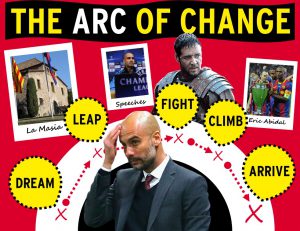 Sir Alf Ramsey once stated that the secret to great coaching and to get your vision across to the players was constant repetition. Repetition, just so happens to be the next major principle that must be adhered to in order to forge a winning culture. It is the recurrence of specific systems and processes that eventually become second nature that allows FC Barcelona to deliver high levels of performance. A perfect example of this is the ‘Rondo,’ a simple piggy in the middle type possession practice. This training exercise forms part of every training session and constantly re-affirms the importance of keeping possession of the ball which is one of Guardiola’s two key tactical messages.
Sir Alf Ramsey once stated that the secret to great coaching and to get your vision across to the players was constant repetition. Repetition, just so happens to be the next major principle that must be adhered to in order to forge a winning culture. It is the recurrence of specific systems and processes that eventually become second nature that allows FC Barcelona to deliver high levels of performance. A perfect example of this is the ‘Rondo,’ a simple piggy in the middle type possession practice. This training exercise forms part of every training session and constantly re-affirms the importance of keeping possession of the ball which is one of Guardiola’s two key tactical messages.
In order to get his style of play across to the players, what Guardiola had to do is change previous habits and in turn install new ones. This process requires repetition as has been mentioned but also discipline. Guardiola enforced several rules on his players placing importance on being six minutes early to training as well as curfews for training days. Although putting your own stamp on the team processes is necessary, it is equally important not to change too much in a short space of time. This may stifle the players and also confuse them particularly when tactical information is being delivered. Therefore, it is vital to approach change by targeting what Charles Duhigg calls ‘Keystone habits.’ These are certain behaviours that once installed set off a chain reaction for shifting other habits and behavioural patterns. For FC Barcelona there were two key stone habits that ensured Guardiola achieved his desired style of play on the pitch.
The first of these was the five second rule where possession must be regained within five seconds of losing the ball. Everything else from fitness to team spirit flowed from this simple tactical cue as it necessitated an intense physical effort from every player. This habit proved extremely effective as it placed the opposition under immense pressure at a vulnerable time. If players were unable to regain the ball within the five seconds then they would revert to plan B which would be to get into a compact shape behind the ball.
The second key stone habit was to dominate possession, specifically to aim for 65-70% in all matches. The intention of this tactical approach is to keep the ball as a form of defence as well as offence. By keeping possession, they are likely to produce more goal scoring opportunities but also the opposition is likely to tire from chasing them down. If the opposition did manage to win the ball, they would be so tired from their efforts that they would surrender it back quickly after, and the cycle would repeat itself.
Through the repetition of two key behaviours (that appear relatively simple but represent a much larger set of tactical principles) Guardiola was able to instil a style of play that the players understood and more importantly successfully reproduced.
 The penultimate principle that is requisite to evoke a winning culture concerns the individuals within the group (i.e the players). There must be informal leaders within the group that set the bar in terms of professionalism and energise the other members. Damian Hughes refers to these individuals as ‘Cultural Architects.’ Each squad needs a minimum of 3-5 architects who personify the coach’s messages and the club’s big picture. During Guardiola’s tenure at FC Barcelona it was Puyol, Xavi, Iniesta, Valdes and Messi that assumed this role.
The penultimate principle that is requisite to evoke a winning culture concerns the individuals within the group (i.e the players). There must be informal leaders within the group that set the bar in terms of professionalism and energise the other members. Damian Hughes refers to these individuals as ‘Cultural Architects.’ Each squad needs a minimum of 3-5 architects who personify the coach’s messages and the club’s big picture. During Guardiola’s tenure at FC Barcelona it was Puyol, Xavi, Iniesta, Valdes and Messi that assumed this role.
Interestingly, the role of a cultural architect comes in various forms and is not limited to a specific set of behaviours. For example, there are the ‘initiators’ (Xavi, Messi) who are the visionaries in the group who drive the team through individual brilliance and innovation. However, having too many architects of this behaviour can be negative for the group and if uncontrolled can lead to arrogance and complacency within the squad. FC Barcelona found themselves in this situation when they went 5-0 up against Rayo Vallecano and Dani Alves and Thiago initiated an elaborate dancing celebration in front of fans of a side that were doomed for relegation. Puyol immediately rushed over to put a stop to the celebration and ushered them back to their positions for the restart. In this scenario Puyol showed his cultural influence as a ‘Blocker’ whose responsibility is to simply say no in order to keep everyone else right. The role of the blocker is also to play devil’s advocate to ensure that the behaviours of the team are absolutely correct. The final type of architect is the ‘Backbone’ (Iniesta, Valdes) who are there to support the group in a more general manner. These individuals tend to lead by example and transmit a special dedication to the club to the other players.
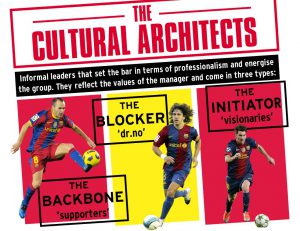 The final principle to follow to attain a winning culture is that of authentic leadership. Damian Hughes identifies that an authentic leader must have three characteristics. These are cultural compatibility, consistency and transparency. Guardiola, being from Catalonia and having progressed through La Masia himself as well as being mentored by Johan Cruyff as player and coach is quite frankly the perfect cultural fit. Additionally, Guardiola has a drive to be the best and ensures that he is continually learning so that he can be the best version of himself. To achieve this Guardiola surrounds himself with experts and also leans on outside influences away from FC Barcelona to develop. His coaching influences extend beyond Cruyff and he sites Juan Manuel Lillo and Marcelo Bielsa as key in his tactical development as a coach. Similarly, his assistant Manuel Estiarte played water polo as his primary sport where input from someone outside the football world can be refreshingly insightful.
The final principle to follow to attain a winning culture is that of authentic leadership. Damian Hughes identifies that an authentic leader must have three characteristics. These are cultural compatibility, consistency and transparency. Guardiola, being from Catalonia and having progressed through La Masia himself as well as being mentored by Johan Cruyff as player and coach is quite frankly the perfect cultural fit. Additionally, Guardiola has a drive to be the best and ensures that he is continually learning so that he can be the best version of himself. To achieve this Guardiola surrounds himself with experts and also leans on outside influences away from FC Barcelona to develop. His coaching influences extend beyond Cruyff and he sites Juan Manuel Lillo and Marcelo Bielsa as key in his tactical development as a coach. Similarly, his assistant Manuel Estiarte played water polo as his primary sport where input from someone outside the football world can be refreshingly insightful.
As a leader it is important to allow the players to use their own judgement but at the same time they need to ensure it is correct and consistent. To achieve this Guardiola places great importance on three major trademark behaviours, which, he believes act as guard rails wide enough to empower but narrow enough to guide. These three behaviours are to show humility, to work hard and to put the team first. This ensures that different people make similar decisions in similar circumstances. The reason why the behaviours are present as well as the consequences of not adhering to them are clearly outlined to the players. By living by the values, as well as having the cultural architects reflecting his messages renders Guardiola both consistent and transparent.
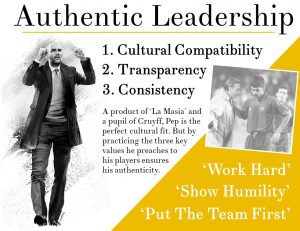 To conclude, it is clear that taking the FC Barcelona blue print outlined above and directly applying it to another football club is not going to guarantee success. However, Damian Hughes has identified an excellent framework through the five overarching principles that has made the understanding of culture in sport a bit more objective. Consequently, there is a clear strategy for other teams and sports to follow, which, if done as meticulously as FC Barcelona, may permit them to unearth their own winning culture and sporting dynasty.
To conclude, it is clear that taking the FC Barcelona blue print outlined above and directly applying it to another football club is not going to guarantee success. However, Damian Hughes has identified an excellent framework through the five overarching principles that has made the understanding of culture in sport a bit more objective. Consequently, there is a clear strategy for other teams and sports to follow, which, if done as meticulously as FC Barcelona, may permit them to unearth their own winning culture and sporting dynasty.
Hughes, D. (2018). The Barcelona Way – Unlocking the DNA of a winning culture. London: Macmillan.
